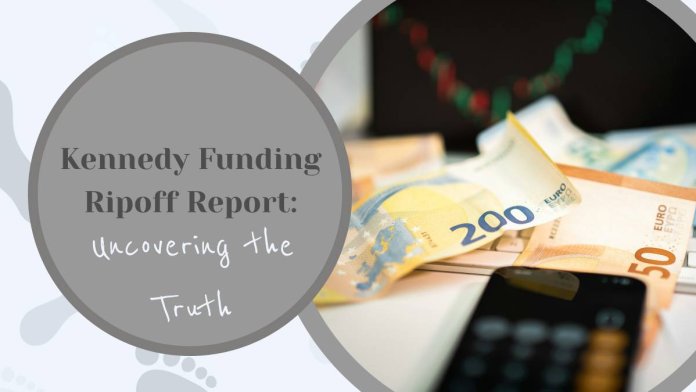In a world where financial opportunities often dangle like tempting bait, the story of Kennedy Funding looms large as both a warning and a lesson. Promising quick capital for investors and real estate projects alike, this company has attracted countless hopefuls seeking to turn their dreams into reality. Yet beneath the surface of glossy brochures and persuasive pitches lies a darker narrative that begs scrutiny. What happens when those dreams morph into nightmares?
As whispers of discontent grow louder, tales of frustration and unmet expectations have emerged from former clients who feel betrayed by what they perceived as misleading assurances. In this article, we embark on an investigative journey through the intricate web of Kennedy Funding’s operations—dissecting testimonials that paint a picture fraught with disappointment while also striving to uncover the truth behind these claims. Buckle up as we sift through the facts, confront the controversies, and explore whether Kennedy Funding is indeed a promising partner or simply another name in an ever-expanding list of financial pitfalls.
Background: What is Kennedy Funding?
Kennedy Funding is a private money lender that has made its mark in the real estate and construction sectors by providing fast, flexible financing solutions. Founded in 1997, the company specializes in hard money loans, offering capital for various projects ranging from residential properties to large commercial developments. Unlike traditional banks, Kennedy Funding often prioritizes property value over credit history, making it an appealing option for borrowers seeking quick access to funds.
However, this unorthodox approach has led to a mixed reputation within the industry. While many clients praise the speed and efficiency of their loan processes, others have raised concerns about transparency and high fees associated with these funding arrangements. The disparity between experiences highlights an essential consideration for potential borrowers: understanding not just the financial terms but also how their needs align with what Kennedy Funding offers. This duality invites scrutiny into whether such lending practices genuinely support developers or create further obstacles disguised as expediency.

The Allegations: Common Complaints and Issues
Numerous allegations against Kennedy Funding often highlight a troubling pattern regarding communication and transparency. Clients report feeling misled about the terms of their loans, with many asserting that vital information was either glossed over or hidden in fine print. This has led to accusations of predatory lending practices, where individuals found themselves ensnared by unexpected fees and onerous conditions that were not fully disclosed upfront.
In addition to financial grievances, complaints frequently touch on customer service experiences—or the lack thereof. Borrowers express frustration over long response times and unhelpful support when issues arise, leaving them in a lurch during critical moments. Many argue that this reflects a broader issue within the company: an apparent prioritization of profit over client welfare. By shedding light on these consistent complaints, potential clients can better navigate the complexities surrounding Kennedy Funding and remain vigilant about their investment choices.
Investigating the Ripoff Reports
Digging deeper into Ripoff Reports reveals a complex landscape of consumer experiences, where individual narratives often clash with corporate reputations. In the case of Kennedy Funding, the reports are more than just vague complaints; they serve as a reflection of wider industry trends and consumer sentiment regarding funding practices. Analyzing these accounts can shed light on systematic issues that may not be immediately apparent in glossy marketing materials or official company statements.
What stands out in many Ripoff Reports is not just dissatisfaction centered around financial transactions but deeper frustrations tied to communication breakdowns and perceived accountability. Consumers frequently express concerns about transparency, illustrating how a lack of clear information can lead to mistrust—even when the product or service ultimately meets their needs. By examining these feelings alongside factual details about Kennedy Funding’s operational model, we invite readers to critically assess not only this specific case but also the implications for broader investment landscapes.

Analyzing Customer Experiences and Testimonials
Delving into customer experiences and testimonials offers a window into the reality of any organization, including Kennedy Funding. While some accounts may emphasize negative encounters, it’s essential to sift through these narratives for overarching patterns that reveal deeper truths. Positive testimonials can lend credibility and illustrate the company’s strengths, but they should be balanced against critical feedback to provide a holistic view.
Interestingly, an analysis of customer sentiment often showcases not just the services rendered but also how clients felt throughout their journey with Kennedy Funding. Testimonials highlighting responsiveness or personalized service indicate areas where the company excels compared to competitors. On the flip side, recurring themes of dissatisfaction—such as communication gaps or unmet expectations—can serve as powerful indicators for prospective clients weighing their options. By synthesizing these insights, we not only uncover potential red flags but also gain a comprehensive understanding of what it truly means to engage with Kennedy Funding in today’s marketplace.
Legal Actions Against Kennedy Funding
Legal actions against Kennedy Funding have stirred considerable debate within the financial community, revealing layers of complexity beyond the surface-level accusations. Critics argue that some of these lawsuits stem from misunderstandings regarding the company’s lending practices and contractual obligations. Often, borrowers may feel overwhelmed by the fine print in agreements they willingly entered into, leading to frustrations that metamorphose into legal disputes. This has led to a narrative where Kennedy Funding is perceived not merely as a lender but as a scapegoat for broader frustrations associated with cash flow challenges in real estate ventures.
Moreover, exploring specific cases sheds light on how some borrowers mismanaged their projects or failed to meet payment schedules while expecting leniency from lenders. In instances where financial difficulties arose unexpectedly, legal routes were pursued as recourse rather than addressing responsibility. This paints an intricate picture of accountability — shifting focus away from just one party’s role in the fallout and inviting stakeholders to consider systemic issues within entrepreneurship and financing models prevalent in today’s market. Thus, as these legal actions unfold, they serve not only as cautionary tales for potential clients but also highlight gaps in understanding between lenders and those seeking funds in increasingly volatile economic landscapes.

Conclusion: The Truth Behind the Allegations
As we peel back the layers surrounding the allegations against Kennedy Funding, a more nuanced picture begins to emerge. While negative reviews often dominate the conversation, it’s essential to consider the motivations and contexts behind these claims. Many customers may have entered into agreements with expectations that didn’t align with reality, leading to dissatisfaction and frustration that spirals into public grievances. Understanding that perspectives can be colored by individual experiences urges us to approach these reports critically.
Additionally, a closer examination reveals patterns in how companies handle customer relationships during challenging transactions. Companies like Kennedy Funding may face systemic issues common in the financial industry – such as miscommunication or misalignment of goals between clients and service providers. Instead of painting all involved parties with broad strokes based on isolated incidents, we should advocate for open dialogue and constructive feedback channels that could potentially lead to shared growth rather than resentment. In a world overflowing with information and opinions, separating truth from perception is not just necessary; it’s our responsibility as informed consumers.
